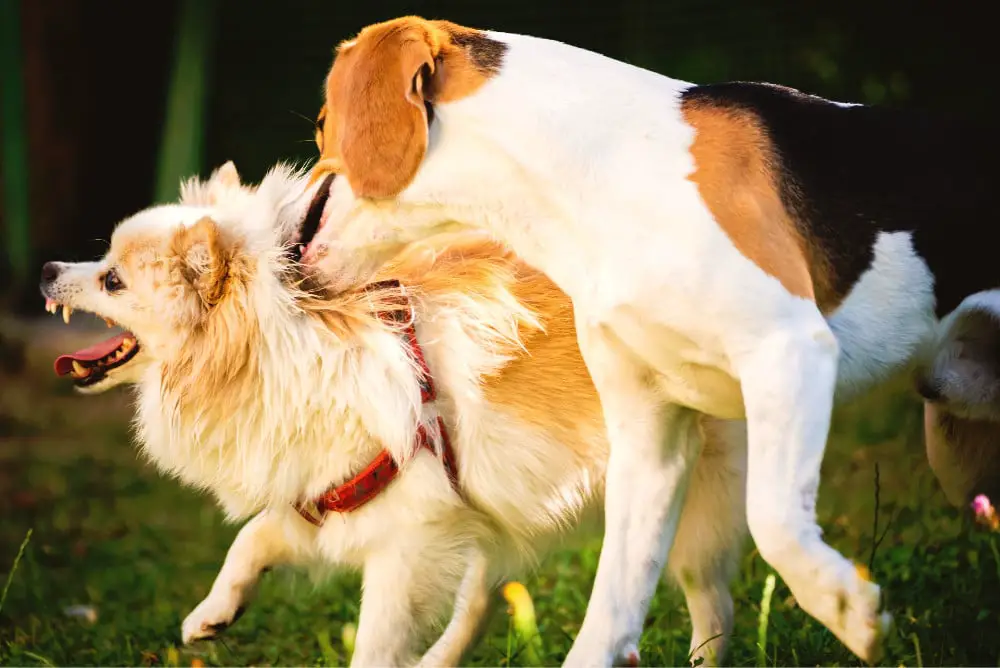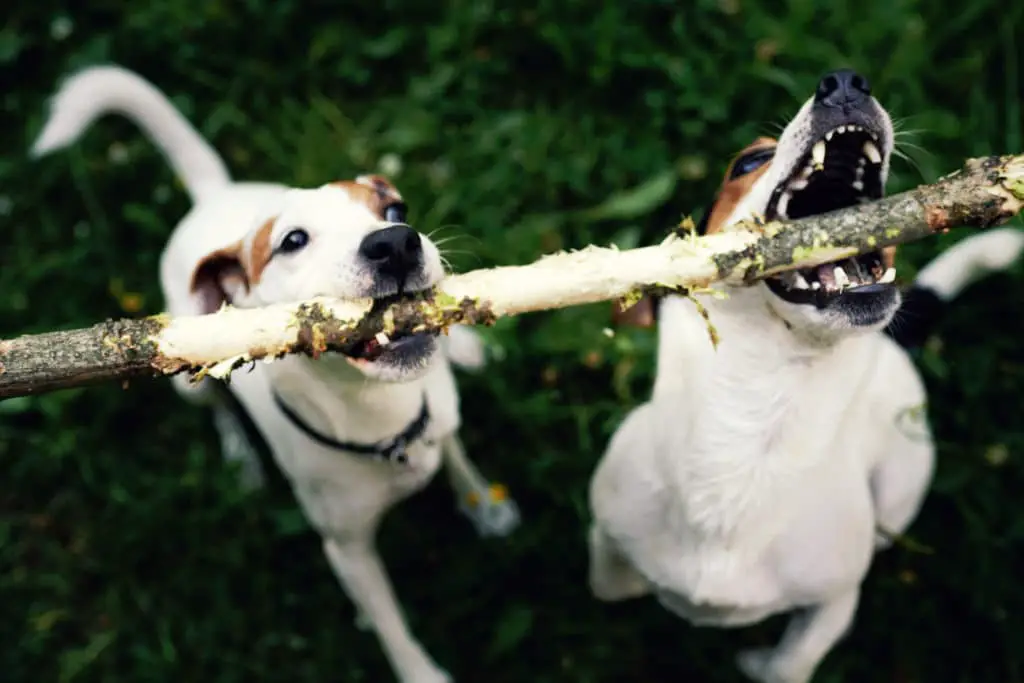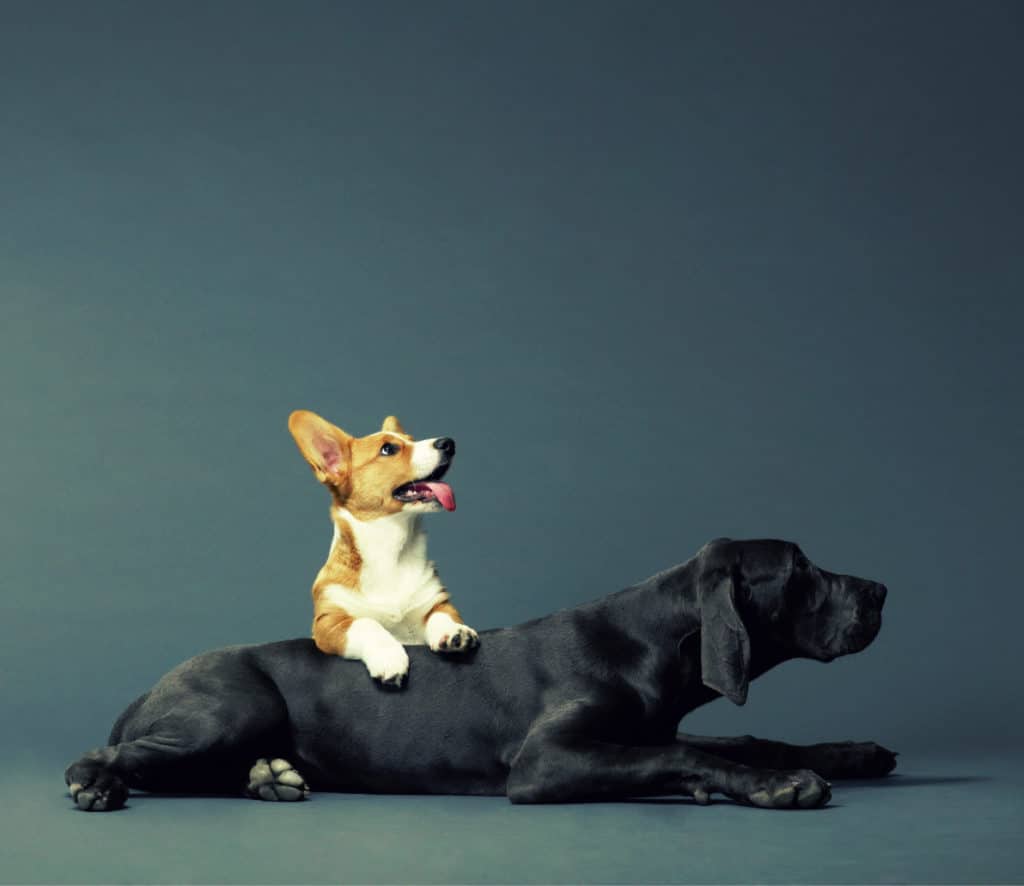Socializing a dog is a crucial part of proper training. Correct socializing will help your doggo become a lovable and affectionate dog. You have to socialize your doggo with other people and other dogs in terms of socializing.
This is where it can get tricky. If you have a dominant dog, other dogs or even their owners would be afraid to introduce their dogs to yours. A dominant dog will show aggressiveness toward others, especially dogs. Also, they would bite the heels of children and other dogs in an attempt to “herd” them. Also, if your doggo is a huge and muscular one, other dogs would be a bit afraid around your dog. A dominant dog can be any dog such as Pit Bulls, German Shepherds, Rottweiler, Doberman, etc. If you have a dominant doggo, then it’s crucial that you socialize them properly so they won’t injure or hurt other people or animals.
If you have that kind of dominant dog, then it would be a delicate situation where you introduce your dominant doggo to a little pup. This is where you ask the question, “How to introduce a puppy to a dominant dog.” This is a question both people who have dominant dogs and people who have little puppies ask. And this question would be even crucial if you have a dominant dog at home and wants to buy a new puppy. So, if you are in need of an answer to that question, these are the easy steps to follow when introducing a puppy to a dominant dog.
If you like to learn about the basics of introducing a puppy to a dominant dog through a video, you can watch this.
Table of Contents
Steps to follow when introducing a puppy to a dominant dog
Keep in mind that a dominant dog and an aggressive dog are two different things. A dominant dog is a dog that has a strong personality who doesn’t like to share its resources with others, especially with another dog.
A dominant dog may mouth other pets (where it looks like the dog is biting but not) and make its own rules while disobeying commands. On the other hand, aggressiveness is where the dog show teeth, growl, lunging, and raise hackles.
But if you are not sure if your doggo is a dominant one or an aggressive one, make sure you get advice from an expert before introducing your dog to a pup.
You have to follow these steps if you have a dominant dog at home and want to buy a new puppy.
First, pick the right puppy for your dominant doggo
If you already have a dominant doggo at home and want to buy a puppy, you have to consider these 3 things about the new pup.
- Personality
- Size
- Gender
Picking the right puppy is as important as introduction.
As a general guideline, dogs get along better with dogs of the same size. Large doggos may see small dogs as prey and try to hurt them.
If you are hoping to get a toy breed such as Shih Tzu, Pomeranian, Maltese, or Toy Poodle, keep in mind that they don’t know how fragile and small they are. So, they may pick a fight with a dog that’s so large and stronger.
Gender is also essential when getting a new puppy. If there are two male dogs in the household, they are likely to fight over females or might get possessive of their owners.
On the other hand, two female doggos may fight violently to protect their territory.
This is why experts always suggest that when you get a second dog, you always get the opposite gender.
On a personal note, I would suggest that it would be ideal if the new puppy would be more submissive than your dominant dog. This would avoid more conflicts in the future.
Luckily, most pups are a bit scared around grown-up dogs and don’t try to pick fights. But that can change when the puppy grows up. So, observe the pup’s interactions with the dog to understand their behavior.

Make preparations
The name of the game is Preparations. You have to create the best environment at home for both the dog and the new puppy to prevent fights and conflicts.
- Buy separate toys, beds, food and water bowls for both dogs
- Gets a separate crate for crate training your pup.
- Puppy proof a separate room where the pup won’t bother the dominant one.
- Get help from the family and friends because you will need one more person to help with the introduction process.
- Make sure that both your new pup and dog are up to date with vaccine shots.
If you like to learn more about crate training a pup, you can visit this link.
Meet on “Neutral” Territory
When introducing two dogs for the first time, the biggest mistake you can make is do that at home.
Keep in mind that your home is already your dominant dog’s territory. So, if you take the new pup home for the first time for introduction, the dominant doggo may see the new pup as a threat and may become aggressive and offensive.
The best way to avoid confliction is to pick a neutral ground for the introduction. This way, the dominant doggo won’t feel threatened by the new pup.
When picking a neutral ground, choosing an enclosed space is better, so you don’t have to worry about the two dogs running away.
Slow Start is always Better.
When introducing the two doggos, have both of them on a leash and keep their distance. This way, the dominant dog won’t react negatively to the new pup.
This is why you need the help of a friend for the introduction.
In the beginning, distract both doggos with toys and treat. Then slowly move them closer and closer when both doggos are relaxed.
When both dogs are closer and within sniffing distance, let them interact without forcing anyone. At this moment, expect tons of snuffing and some barking with excitement.
Your dogs won’t be best friends from this interaction alone. They will have positive first impressions and connect with each other in a positive way. This is the foundation of a lifelong relationship between the two dogs.

Look out for Bad Signs
While doing the introduction, the dominant one might tolerate the puppy or may be hostile.
Observe the body language of the dominant dog to see how tolerant it is of the new pup and also for signs of aggression in the pup.
- If the dominant dog shows a relaxed posture, relaxed ears, and slow wiggling tail with an upright tail, then that means the dominant dog is interested in the new pup. You can let them interact if you see these signs.
- If your dominant dog shows a rigid body, pulled-back ears, stiff tail, lip lifting, and growling, then separate the two dogs because the dominant one is hostile. Try again after a while, and if the dominant dog shows the same reaction, please talk to a specialist.
- It’s totally normal for the new pup to act a bit submissive when interacting with an adult dog. It’s normal if the pup stays low to the ground, holds their tail between their legs, urinate, or crawl.
Keep the Introduction Short & Calm
The first impression should be short and quick. After the initial excitement and suspicion have passed away, bring both dog and the puppy home.
If your pup is old enough and up to date with all vaccinations, you can go for a short walk around the neighborhood before going home.
It’s completely normal for you to be nervous about the first meeting. Nonetheless, try to show calmness and assertiveness. The reason for this is dogs can pick up on our emotions. Therefore, if you are nervous or afraid, your dominant dog might think that the puppy is something negative and act according to that.
You can learn more about how dogs can understand your emotions from this link.

Supervise & Separate
For the first few weeks, it’s better to keep the puppy and the dominant dog separate. The reason for this is, your dominant dog should get comfortable being with another dog in its territory without getting overwhelmed by their presence.
It’s important that your dominant doggo should still feel like the boss. So, the dominant dog should get food, walks, and attention first. Spoil your new pup in private without the dominant one realizing.
For the first few weeks, don’t ever leave the dominant dog and the puppy alone, even for a couple of minutes.
The reason for this is, puppies don’t know how to act around adult dogs, so it might provoke the dominant one by accident. If that happens, you should be there to intervene.
Tips for the First few Weeks
These are some tips you can follow for the first couple of weeks
- Feed the dominant dog and the pup in separate rooms so they won’t have any confrontations relating to food.
- When buying toys, buy toys for both dogs so your dominant doggo won’t feel neglected.
- Have separate one-on-one times with both doggos, and make sure you involve other family members so both dogs, especially the dominant one won’t feel jealous or be mad at you.
- Give plenty of exercise for your pup so it won’t try to disturb the dominant doggo all the time and find activities that both the pup and the dominant dog would enjoy. Then do those activities together so the bond between those two would get stronger.
Dominance is a part of the Dog
A dog’s social life is naturally a hierarchy. In every situation, dogs will live according to that hierarchy. Therefore, a dominant dog will always hold an upper level in that hierarchy thus, the hierarchy will be established even if there are only two dogs. So, when you try to introduce a new pup to a dog like that, it’s natural for that dog to show dominance over the new puppy. This is why you should always show dominance over your dog in dog training. But keep in mind that that doesn’t mean that you punish your dog or let them be scared of you. It simply means that the dog should know that you are the alpha. Otherwise, there may be conflicts.
So, it’s natural for your dominant dog to show dominance over the new pup. What you can do is, let the dominant dog know that it is superior and important to the new puppy so the transition would be smooth. You can do these things to let the dominant one knows that it is superior to the new pup.
- When going outside, allow the dominant doggo to go outside first.
- When feeding, always feed the dominant one first in their own personal space.
- When you come home from work, always give first attention to the dominant dog.
- When going for a walk, take the dominant one first.
The other important thing that happens when you do these things is that the new pup will know its place in the hierarchy while it grows up. So, the new pup will be submissive toward the dominant dog. This will further prevent more conflicts. All of these will eventually make your dominant doggo accept the new pup and won’t be jealous but remember, this process is slow and takes time and patience.

FAQ
- How to introduce a puppy to a Pit Bull?
There is no different way to introduce a puppy to a Pit Bull. Pit Bulls are usually alpha dogs. So, follow the above-mentioned steps to introduce your new pup to a Pit Bull. If your Pit Bull is well trained and socialized properly, then you will have no problem introducing it to a new pup.
If you like to learn more about Pit Bulls, you can visit this article on Pitbull Puppy.
- How to introduce a puppy to a Hyper Dog?
Introducing a puppy to a hyper dog is as same as introducing a puppy to a dominant one. But make sure that you increase the playtime where both dogs play together with time. Eventually, having another playmate would be a good thing for a hyper dog since it has a partner to burn energy with.
- What do I do if my Dog doesn’t like my new puppy?
If your dog doesn’t like the new pup, give it a break and give the dominant dog other things to do. It’s better to get the dominant dog relaxed in this situation, so giving training games, impulse control games, and nosework would be good.
If your dog doesn’t like puppies in general, you need training. You have to interfere and can’t let the dog and the pup work it out.
If that’s the case, you can use this link to learn more about how to train a dog that doesn’t like puppies.
- How long does it take dogs to get used to each other?
This is a slow process, so it would take at least a month for an adult dog to get used to a new puppy. If the adult dog is more dominant, then that time can increase more. Keep in mind that this is a work in progress. So, you can’t expect results right away.



Pingback: Border Collie Puppy and all you need to know about them